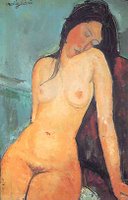Modigliani

Born to affluent Jewish parents on this day in 1884 in Livorno, Italy, Amedeo Modligliani, known as "Modi" to his friends, gathered his early artistic training in Italy -- steeping himself in Italian Renaissance traditions (including the work of Botticelli, who many critics see as Modigliani's spiritual ancestor), painting in a proto-Impressionist Macchiaioli style, and enjoying the life of a well-dressed playboy. In 1906 he arrived in Paris, where he became the model cafe-haunting bohemian, scratching out a living in a garret, womanizing and drinking to excess. Artistically, he became intrigued by the work of Cezanne and the experimentations of Picasso's "Negro Period," with its affinity for the elongated, stylized portraiture of African masks.
With these influences and a predilection for linear grace, he continued to paint in moderate obscurity until, under the influence of his friend Constantin Brancusi, he turned exclusively to sculpture in 1909, crafting limestone portraits under the influence of Greek kouroi as well as African masks. When sculpting materials became difficult to find with the onset of World War I, Modigliani returned to painting, although his style was now more boldly informed by his sculpting.
 His paintings after 1914, almost exclusively portraits and nudes, had the feeling of sculptural objects -- detached from any realistic or definable background, contoured as with a chisel, with long necks, flat almond-shaped eyes, widely-set nostrils at the ends of profile noses in full face, and small, sad mouths, all enclosed within clearly drawn yet elegant outlines and roughly washed in thinly-applied paint. Unlike his inscrutable African mask antecedents, however, Modigliani's portraits were personal; they showed, without any sign of ham-fisted exaggeration, the moods and eccentricities of his subjects (such as his portraits of Max Jacob, Jacques Lipchitz and his wife, Jean Cocteau, and Chaim Soutine). His serene, subtly elongated nudes (such as his Nude, Courtauld Gallery, London, c. 1916, considered scandalous in its day and removed from a gallery window by order of the gendarmes; Nude on a Cushion, Collection Gianni Mattioli, Milan, 1917-18; and Reclining Nude, MOMA, New York, c. 1919) are of the same style, dominated by the delicate sweep of curved outlines and lushly graded flesh tones; they are in Arnason's words, "among the most beautiful and sensuous in the whole of art."
His paintings after 1914, almost exclusively portraits and nudes, had the feeling of sculptural objects -- detached from any realistic or definable background, contoured as with a chisel, with long necks, flat almond-shaped eyes, widely-set nostrils at the ends of profile noses in full face, and small, sad mouths, all enclosed within clearly drawn yet elegant outlines and roughly washed in thinly-applied paint. Unlike his inscrutable African mask antecedents, however, Modigliani's portraits were personal; they showed, without any sign of ham-fisted exaggeration, the moods and eccentricities of his subjects (such as his portraits of Max Jacob, Jacques Lipchitz and his wife, Jean Cocteau, and Chaim Soutine). His serene, subtly elongated nudes (such as his Nude, Courtauld Gallery, London, c. 1916, considered scandalous in its day and removed from a gallery window by order of the gendarmes; Nude on a Cushion, Collection Gianni Mattioli, Milan, 1917-18; and Reclining Nude, MOMA, New York, c. 1919) are of the same style, dominated by the delicate sweep of curved outlines and lushly graded flesh tones; they are in Arnason's words, "among the most beautiful and sensuous in the whole of art."By the age of 35, however, Modigliani had descended deeply into alcohol and opium, and was plagued by tuberculosis. He had fathered a child by an teenaged art student, Jeanne Hebuterne, and she was pregnant with his second child when Modigliani succumbed to tubercular meningitis on January 24, 1920 in Paris. Just a few days after Modigliani's death, Jeanne committed suicide by throwing herself out of her parents' window.
Labels: Painting and Sculpture, Paris





0 Comments:
Post a Comment
Subscribe to Post Comments [Atom]
<< Home